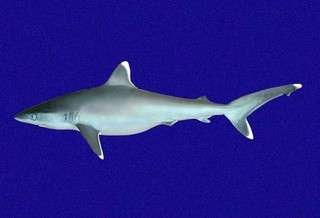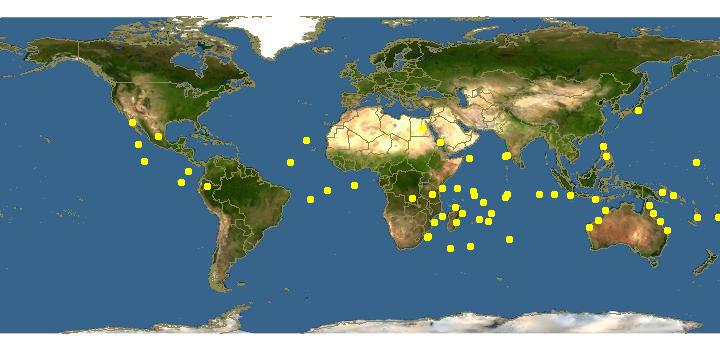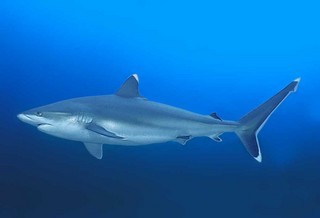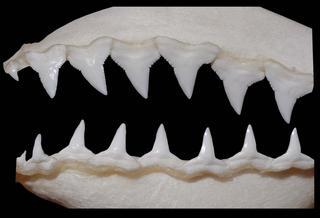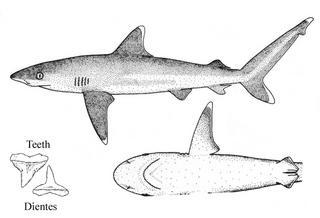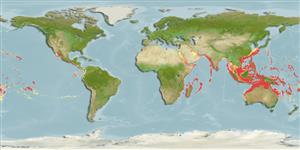|
| Links |
We parsed the following live from the Web into this page. Such content is managed by its original site and not cached on Discover Life. Please send feedback and corrections directly to the source. See original regarding copyrights and terms of use.
- Australian Faunal Directory
- FishBase
|
|
español |
|
|
Overview |
Main identification features
- 1st dorsal fin and pectoral: pointed
- white tips: 1st dorsal fin pectoral, tail fin
Snout moderately long and broadly rounded, length in front of mouth 6.8-9.2% of total length; ridge present on back between dorsal fins; origin of first dorsal fin over or slightly before inner pectoral corner; height of first dorsal 7.1-10.6% of total length; apex of first dorsal bluntly to sharply pointed; origin of second dorsal over or slightly behind origin of anal fin, pectoral fin pointed.
Grey, darker on back and shading to white ventrally; distinctive white tips or margins on first dorsal, tail, and pectoral fins.
Grows to 300 cm; size at birth 55-80 cm.
Habitat: coastal-pelagic, inshore to offshore; common on outer reef slopes.
Depth: 0-800 m, usually below ~20 m.
Tropical Indo-Pacific; southern Baja and the Gulf of California to Ecuador, all the offshore islands.
Attributes
Abundance: Common.
Cites: Not listed.
Climate Zone: North Temperate (Californian Province &/or Northern Gulf of California); Northern Subtropical (Cortez Province + Sinaloan Gap); Northern Tropical (Mexican Province to Nicaragua + Revillagigedos); Equatorial (Costa Rica to Ecuador + Galapagos, Clipperton, Cocos, Malpelo).
Depth Range Max: 800 m.
Depth Range Min: 0 m.
Diet: sharks/rays; octopus/squid/cuttlefish; bony fishes.
Eastern Pacific Range: Northern limit=32; Southern limit=-3; Western limit=-115; Eastern limit=-78; Latitudinal range=35; Longitudinal range=37.
Egg Type: Live birth; No pelagic larva.
Feeding Group: Carnivore.
FishBase Habitat: Reef Associated.
Global Endemism: All Pacific (West + Central + East); Indo-Pacific only (Indian + Pacific Oceans); TEP non-endemic; "Transpacific" (East + Central &/or West Pacific); All species.
Habitat: Reef associated (reef + edges-water column & soft bottom); Water column.
Inshore Offshore: Inshore; Inshore Only.
IUCN Red List: Not evaluated / Listed.
Length Max: 300 cm.
Regional Endemism: Island (s); Continent; Continent + Island (s); Eastern Pacific non-endemic; Tropical Eastern Pacific (TEP) non-endemic; All species.
Residency: Resident.
Salinity: Marine; Marine Only.
Water Column Position: Mid Water; Near Bottom; Near Surface; Water column only;
|
|
|
Names | |
|
|
|
Links to other sites | |
|
|
|
References |
- Allen , G.R. and Robertson, D.R., 1997., An Annotated Checklist of the fishes of Clipperton Atoll, Tropical Eastern Pacific., Revista de Biologia Tropical, 45:813-843.
- Bellido-Millán, J.M. and Villavicencio-Garayzar, C.J., 2002., Pesqueria artesanal de tiburon en la region central del Golfo de California. En: Lozano-Vilano, M. L. (Ed.). Libro Jubilar en Honor al Dr. Salvador Contreras Balderas., Universidad Autonoma de Nuevo León:143-152.
- Béarez, P., 1996., Lista de los Peces Marinos del Ecuador Continental., Revista de Biologia Tropical, 44:731-741.
- Castro-Aguirre, J.L. and Balart, E.F., 2002., La ictiofauna de las islas Revillagigedos y sus relaciones zoogeograficas, con comentarios acerca de su origen y evolucion. En: Lozano-Vilano, M. L. (Ed.). Libro Jubilar en Honor al Dr. Salvador Contreras Balderas., Universidad Autonoma de Nuevo León:153-170.
- Compagno, L.J.V., 1999., Checklist of living elasmobranchs. In Hamlett W.C. (ed.) Sharks, skates, and rays: the biology of elasmobranch fishes., The John Hopkins University Press:471-498.
- Compagno, L.J.V., 1984., Sharks of the World. An annotated and illustrated catalogue of shark species known to date. Part 2. Carcharhiniformes. FAO Species Catalogue., FAO Fish. Synop. No 125, 4(2):251-655.
- Findley, L.T., Hendrickx, M.E., Brusca, R.C., van der Heiden, A.M., Hastings, P.A., Torre, J., 2003., Diversidad de la Macrofauna Marina del Golfo de California, Mexico., CD-ROM versión 1.0. Projecto de la Macrofauna del Golfo . Derechos reservados de los autores y Conservación Internacional.
- Fischer , W. , Krup , F. , Schneider , W. , Sommer , C. , Carpenter , K. E. and Niem, V. H., 1995., Guia FAO para la Identificacion de Especies de para los fines de la Pesca. Pacifico Centro-Oriental. Volumen II. Vertebrados - Parte 1., FAO2:647-1200.
- Galván-Magaña, F., Abitia-Cárdenas, L.A., Rodríguez-Romero, J., Pérez-España, H., Chávez-Ramos, H., 1996., Systematics list of the fishes from Cerralvo island, Baja California Sur, Mexico., Ciencias Marinas, 22:295-311.
- Galván-Magaña, F., Gutiérrez-Sánchez, F., Abitia-Cárdenas, L.A., Rodríguez-Romero, J., 2000., The distribution and affinities of the shore fishes of the Baja California Sur lagoons. In Aquatic Ecosystems of Mexico: Status and Scope. Eds. M. Manuwar, S.G. Lawrence, I.F. Manuwar & D.F. Malley. Ecovision World Monograph Series., Backhuys Publishers:383-398.
- Humann, P., 1993., Reef Fish Identification: Galapagos., New World Publishing:192pp.
- Jimenez-Prado, P., Béarez, P., 2004., Peces marinos del Ecuador continental / Marine fishes of continental Ecuador., SIMBIOE/NAZCA/IFEA tomo 1 y 2.
- Jordan , and McGregor,., 1898., List of fishes collected at the Revillagigedo archipelago and neighboring islands., Rept. U.S. Fisheries Comm., 24:271-284.
- Lopez , M. I. and Bussing, W. A., 1982., Lista provisional de los peces marinos de la Costa Rica., Revista de Biologia Tropical, 30(1):5-26.
- Love, M.S., Mecklenburg, C.W., Mecklenburg, T.A., Thorsteinson, L.K., 2005., es of the West Coast and Alaska: a checklist of North Pacific and Artic Ocena species from Baja California to the Alaska-Yukon border., U.S. Department of the Interior, U.S. Geological Survey, Biological Resources Division, 288pp.
- Madrid Vera , J. , Ruíz Luna , A. and Rosado Bravo, I., 1998., Peces de la plataforma continental de Michoacán y sus relaciones regionales en el Pacífico mexicano., Revista de Biologia Tropical, 42(2):267-276.
- Ricker, K.E., 1959., Fishes collected from the Revillagigedo Islands during the 1954-1958 cruises of the "Marijean."., Univ. Brit. Columbia Inst. Fish., Mus. Contrib., 4:10pp.
- Robertson , D.R. and Allen, G.A., 1996., Zoogeography of the shorefish fauna of Clipperton Atoll., Coral Reefs, 15:121-131.
- Rubio, E.A., 1986., Notas sobre la ictiofauna de la Isla de Gorgona, Colombia., Boletin Ecotropica. Univ. Bog. Jorge Tadeo Lozano, 13:86-112.
- Rüppell, W. P. E. S., 1837., Neue Wirbelthiere zu der Fauna von Abyssinien gehörig., Fische des Rothen Meeres, 1837:53-80.
- Snodgrass , R. E. and Heller, E., 1905., Papers from the Hopkins Stanford Galapagos expedition, 1898-1899. XVII. Shorefishes of the Revillagigedo, Clipperton, Cocos and Galapagos Island., Proc. Wash. Acad. Sci., 6:333-427.
- Van der Heiden , A. M. and Findley, L. T., 1988., Lista de los peces marinos del sur de Sinaloa, México., Anales del Centro de Ciencias del Mar y Limnologia de la Universidad Autonoma Nacional de Mexico, 15:209-224.
- Walker, B. W. and Baldwin, W. J., 1964., Provisional check list of fishes of the Revillagigedo islands., 18 pp.
|
|
|
Acknowledgements | |
I thank Ashley MacDonald and John Pickering, University of Georgia, for technical support in building this page.
|
|
| Supported by | |
|
Following modified from Australian Faunal Directory
|
Top | See original
| &pull 20q v5.145 20180528: Error 301 Moved Permanently http://biodiversity.org.au/afd/taxa/33005052-9753-4fca-9291-e7ec028e3d3e/ |
|
Following modified from FishBase
|
Top | See original
http://www.fishbase.org/Summary/speciesSummary.php?genusname=Carcharhinus&speciesname=albimarginatus ---> http://192.134.151.83/Summary/speciesSummary.php?genusname=Carcharhinus&speciesname=albimarginatus
http://192.134.151.83/Summary/speciesSummary.php?genusname=Carcharhinus&speciesname=albimarginatus ---> https://fishbase.mnhn.fr/Summary/speciesSummary.php?genusname=Carcharhinus&speciesname=albimarginatus
https://fishbase.mnhn.fr/Summary/speciesSummary.php?genusname=Carcharhinus&speciesname=albimarginatus ---> https://fishbase.mnhn.fr/summary/Carcharhinus-albimarginatus.html
Carcharhinus albimarginatus, Silvertip shark : fisheries, gamefish

You can
sponsor
this page
Common name (e.g. trout)
Genus + Species (e.g. Gadus morhua)
-

-
About this page
-
Languages
-
User feedbacks
-
Citation
-
Uploads
-
Related species
-


 Silvertip shark
Add your observation in
Fish Watcher
Upload your
photos
and
videos
Silvertip shark
Add your observation in
Fish Watcher
Upload your
photos
and
videos
Pictures
|
Videos |
Google image
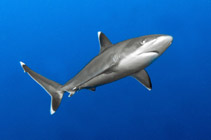 Carcharhinus albimarginatus
Carcharhinus albimarginatus
Picture by
Honeycutt, K.
Elasmobranchii (sharks and rays) >
Carcharhiniformes
(Ground sharks) >
Carcharhinidae
(Requiem sharks)
Etymology:
Carcharhinus:
karcharos
(Gr.), sharp or jagged;
rhinus
, an ancient name for sharks, from
rhine
(Gr.), rasp, both words alluding to a shark's jagged, rasp-like skin. (
See ETYFish
)
;
albimarginatus:
albus
(L.), white;
marginatus
(L.), bordered, referring to white fin tips. (
See ETYFish
)
.
More on author:
Rüppell
.
Environment: milieu / climate zone / depth range / distribution range
Ecology
Marine; reef-associated; depth range 1 - 800 m (Ref.
6871
), usually 20 - ? m (Ref.
30874
). Tropical; 32°N - 31°S, 31°E - 77°W (Ref.
55177
)
Indo-Pacific: Red Sea and East Africa, including Madagascar, Seychelles, Aldabra Group, Mauritius and the Chagos Archipelago east to Tuamotu Is., north to Japan and south to Australia (Ref.
244
). Not confirmed in west Atlantic (Ref.
58085
).
Length at first maturity / Size / Weight / Age
Maturity: L
m
187.3
, range 160 - 200 cm
Max length : 300 cm TL male/unsexed; (Ref.
2334
); common length : 200 cm NG male/unsexed; (Ref.
30874
); max. published weight: 162.2 kg (Ref.
40637
)
Dorsal
spines
(total): 0;
Dorsal
soft rays
(total): 0;
Anal
spines
: 0;
Anal
soft rays
: 0. First dorsal fin and pectoral fins angular, and not expanded; upper teeth triangular; interdorsal ridge present (Ref.
1602
,
5578
). Dark grey or grey-brown above, white below; all fins with conspicuous white tips and posterior margins (Ref.
9997
).
An inshore and offshore shark found over or adjacent to continental and insular shelves and offshore banks (Ref.
244
). Prefers offshore islands, coral reefs and banks (Ref.
244
). Benthopelagic (Ref.
58302
). Feeds mainly on benthic and midwater fishes (including scombrids), also rays, cephalopods (Ref.
244
,
1602
), and small sharks and crustaceans (Ref.
89972
). Viviparous (Ref.
50449
). Up to 11 young, size 50 to 60 cm, are born after a gestation period of 12 months (Ref.
1602
,
37816
). Potentially dangerous (Ref.
9997
). Presumably taken by fisheries in areas where it occurs (Ref.
9997
). Caught irregularly by shark and tuna longline and tuna gillnet fisheries. Utilized for its fins (high value in adults), meat, skin and cartilage (Ref.58048). Probably utilized fresh and dried-salted for human consumption (Ref.
9997
).
Viviparous, placental (Ref.
50449
). With 1 to 11 pups per litter (usually 5 or 6) (Ref.
244
). Gestation period is about one year, young are born in summer (Ref.
244
). Size at birth 55 to 80 cm (Ref.
2334
); 713-81 cm TL (Ref.58048). In southern hemisphere, both breeding and pupping occur in summer (Ref.
37816
). Distinct pairing with embrace (Ref.
205
).
Compagno, L.J.V.
, 1984. FAO Species Catalogue. Vol. 4. Sharks of the world. An annotated and illustrated catalogue of shark species known to date. Part 2 - Carcharhiniformes. FAO Fish. Synop. 125(4/2):251-655. Rome: FAO. (Ref.
244
)
IUCN Red List Status (Ref.
130435
)
Vulnerable (VU)
(A2bd); Date assessed:
17 February 2015
CITES
Appendix II:
International trade monitored
Not Evaluated
Threat to humans
Traumatogenic (Ref.
4690
)
Human uses
Fisheries: commercial; gamefish: yes
FAO - Publication:
search
|
FishSource
|
Sea Around Us
More information
Countries
FAO areas
Ecosystems
Occurrences
Introductions
Stocks
Ecology
Diet
Food items
Food consumption
Ration
Common names
Synonyms
Metabolism
Predators
Ecotoxicology
Reproduction
Maturity
Spawning
Spawning aggregation
Fecundity
Eggs
Egg development
Age/Size
Growth
Length-weight
Length-length
Length-frequencies
Morphometrics
Morphology
Larvae
Larval dynamics
Recruitment
Abundance
BRUVS
References
Aquaculture
Aquaculture profile
Strains
Genetics
Electrophoreses
Heritability
Diseases
Processing
Nutrients
Mass conversion
Collaborators
Pictures
Stamps, Coins Misc.
Sounds
Ciguatera
Speed
Swim. type
Gill area
Otoliths
Brains
Vision
Tools
Bio-Quiz
|
E-book
|
Field guide
|
Identification keys
|
Length-frequency wizard
|
Life-history tool
|
Point map
|
Classification Tree
|
Catch-MSY
|
Special reports
Check for Aquarium maintenance
|
Check for Species Fact Sheets
|
Check for Aquaculture Fact Sheets
Download XML
Summary page
|
Point data
|
Common names
|
Photos
Internet sources
AFORO (otoliths) |
Aquatic Commons
|
BHL
|
Cloffa
|
BOLDSystems
|
Websites from users
|
Check FishWatcher
|
CISTI
|
Catalog of Fishes
:
genus
,
species
|
DiscoverLife
|
ECOTOX
| FAO - Publication:
search
|
Faunafri
| Fishipedia |
Fishtrace
| GenBank:
genome
,
nucleotide
|
GloBI
|
Google Books
|
Google Scholar
|
Google
|
IGFA World Record
|
MitoFish
|
National databases
|
Otolith Atlas of Taiwan Fishes
|
PubMed
|
Reef Life Survey
|
Socotra Atlas
|
Tree of Life
| Wikipedia:
Go
,
Search
| World Records Freshwater Fishing |
Zoological Record
Estimates based on models
Preferred temperature (Ref.
123201
): 13.9 - 29, mean 27.1 °C (based on 4094 cells).
Phylogenetic diversity index (Ref.
82804
): PD
50
= 0.5000 [Uniqueness, from 0.5 = low to 2.0 = high].
Bayesian length-weight: a=0.00437 (0.00215 - 0.00887), b=3.09 (2.92 - 3.26), in cm total length, based on LWR estimates for this species & Genus-body shape (Ref.
93245
).
Trophic level (Ref.
69278
): 4.2 ±0.5 se; based on diet studies.
Resilience (Ref.
120179
): Very Low, minimum population doubling time more than 14 years (Fec=1).
Fishing Vulnerability (Ref.
59153
): Very high vulnerability (90 of 100).
Price category (Ref.
80766
):
Medium
.
Nutrients (Ref.
124155
): Calcium = 4.53 [0.96, 23.65] mg/100g; Iron = 0.345 [0.087, 0.987] mg/100g; Protein = 22 [19, 24] %; Omega3 = 0.116 [0.047, 0.277] g/100g; Selenium = 55 [16, 154] μg/100g; VitaminA = 40.5 [15.2, 111.1] μg/100g; Zinc = 0.488 [0.233, 0.953] mg/100g (wet weight);
Back to Search
Random Species
Back to Top
Accessed through:
Not available
FishBase mirror site :
localhost
Page last modified by :
mrius-barile
- 20 July 2016
Fatal error
: Uncaught ArgumentCountError: Too few arguments to function checkEcotox(), 1 passed in /var/www/html/summary/speciessummary.php on line 2304 and exactly 3 expected in /var/www/html/includes/speciessummary.lib.php:2579 Stack trace: #0 /var/www/html/summary/speciessummary.php(2304): checkEcotox() #1 {main} thrown in
/var/www/html/includes/speciessummary.lib.php
on line
2579
|
Updated: 2024-04-19 06:06:32 gmt
|
